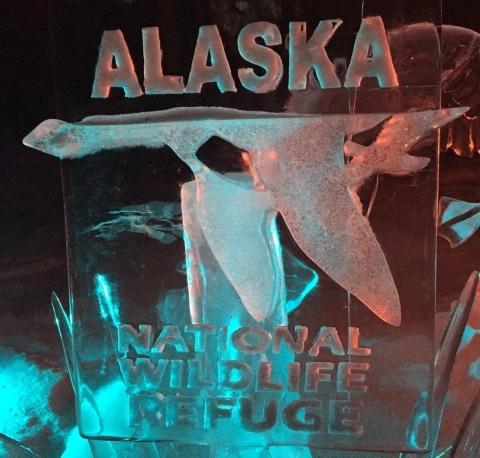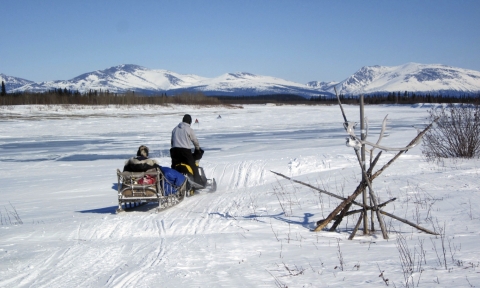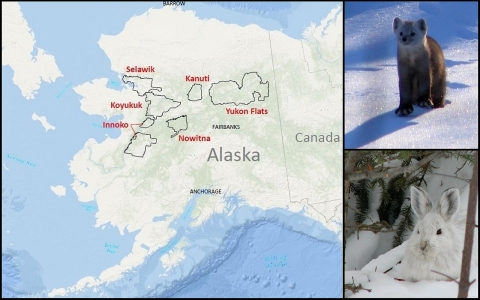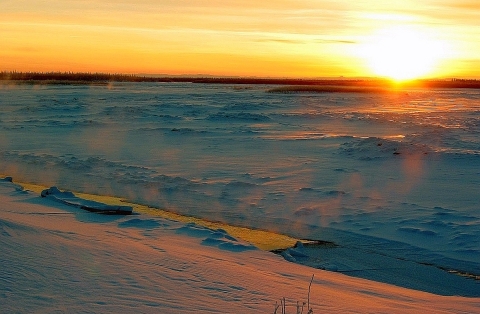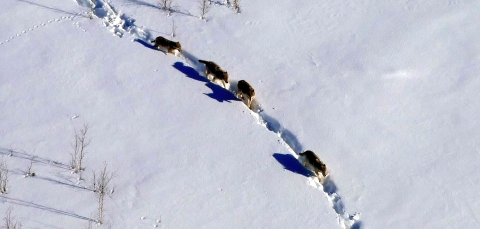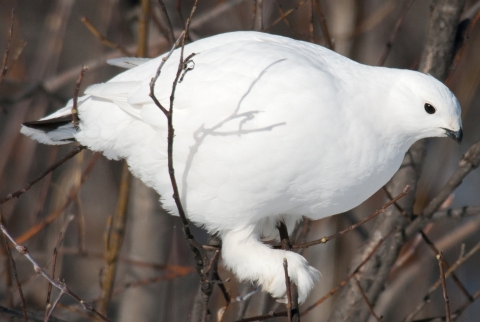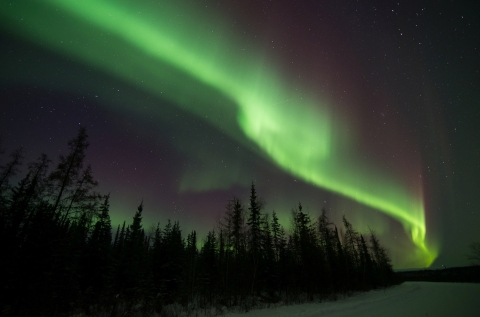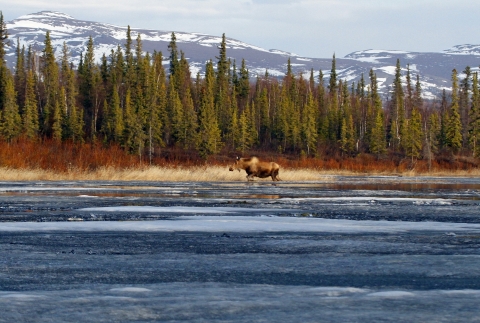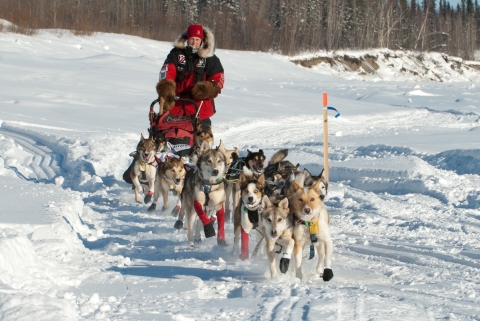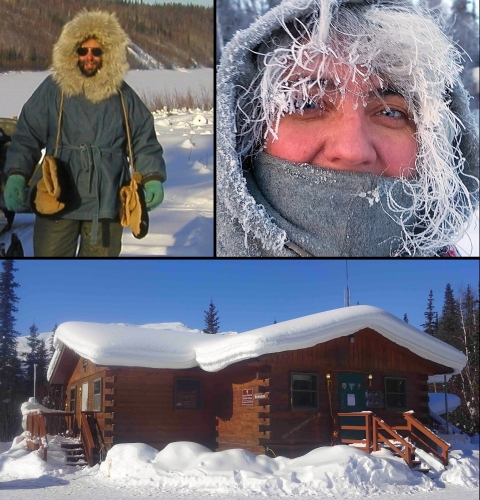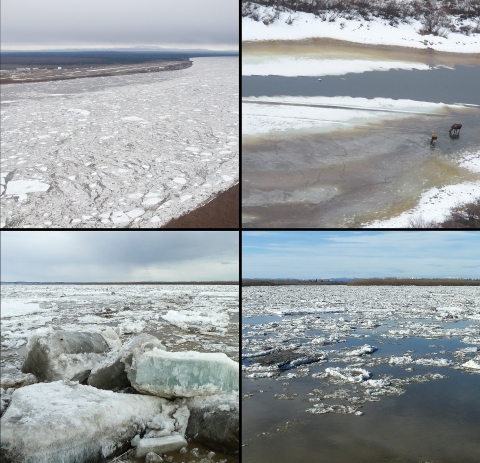In the heart of Alaska, winter starts in October and doesn’t end until May.
Winter is extremely cold and long. That’s the way people and wildlife living in Alaska seem to like it.
“Most of us look forward to winter,” says Susan Georgette, former manager at Selawik National Wildlife Refuge on the western edge of the heart of Alaska. “Of course, the winters are long, and we’re all happy for boating season when it finally rolls around again. But we’re mostly all happy for the return of the cold, snow and darkness.”
Georgette ticks off benefits of winter:
- “No mosquitoes.”
- “We can travel anywhere over the ice and snow, whereas in summer we’re limited to the rivers and ocean in our boats. There are no roads here.”
- “Subsistence foods can easily be preserved outdoors—chilled or frozen in our sheds or unheated entryways.”
- “We can catch up on our sleep after months of the midnight sun.”
- “We can see the stars, moon and Northern Lights again.”
- “We’re not too hot.”
People and wildlife at the national wildlife refuges on the map above live in winter conditions many of us would find hard to imagine.
Because Earth is tilted on its axis, the heart of Alaska is dark for most of the day at the height of winter. From early November to early February, Fairbanks has fewer than seven hours of sunlight a day. On the winter solstice in late December, Fairbanks has 3 hours 41 minutes of sunlight. In Barrow, Alaska’s northernmost city, the sun sets in mid-November and doesn’t rise until mid-January.
“Many people imagine the cold and dark as something painful or desolate, but it’s the absolute opposite,” says Kristin Reakoff, a Kanuti National Wildlife Refuge ranger. “There is something complete in Arctic winters, something whole and connected to how things are meant to be. To walk long and hard in snow, winter hush and low light—over frozen rivers, across narrow willow bars and through the heart of silent forests, moonlight pulling at the edges of your awareness—is to know the very essence of being human.”
The record low temperature in Fort Yukon—a settlement of about 600 people within Yukon Flats National Wildlife Refuge—is minus 78 degrees Fahrenheit (temperature, not wind chill). If you consider that the record summer high is 100 degrees, this makes for one of the most extreme temperature ranges on Earth (a 178-degree swing).
“One moment stands out,” says Delia Vargas Kretsinger, a Yukon Flats Refuge botanist. “During a recent winter project, I stepped outside the cabin late at night, with snow crunching underfoot, to take in the full moon, stars and Northern Lights over Canvasback Lake. After leaving the protective cover of white spruce along the shore to go onto the lake, I was hit with a stiff breeze that took my breath away. Never had I felt so alive in one moment but also insignificant in the larger scope of our universe.”
Many bird, fish and wildlife species spend summer in the heart of Alaska but migrate away when the season turns. Those that stay are biologically adapted to winter.
“All the Arctic animals, from the smallest critters to the largest mammals, are uniquely designed not only to survive in the Arctic extremes, but to thrive,” says Kenton Moos, former manager of Koyukuk, Nowitna and Innoko National Wildlife Refuges who is now at Togiak National Wildlife Refuge in southwestern Alaska. “Some sleep in insulated burrows, while others are protected by their fur or feathered coats. Others somehow survive frozen, yet alive.”
One example of how animals have evolved for winter: Lynx, snowshoe hares and wolves have large feet in proportion to their body size so they can run on top of the snow.
Deep snow is a boon to some animals and a hindrance to others. For rodents and other small mammals, deep snow is a warm, protective blanket. For moose and caribou, deep snow can make escaping from wolves difficult.
Talk about adaptation. The ptarmigan [pronounced TAR-mi-gen] changes color to blend in with its surroundings. It is pure white in winter (above) and becomes mottled dark and white after the snows melt.
“Ptarmigans are the quintessential birds of winter,” says Selawik Refuge outreach specialist Brittany Sweeney. “Their color-changing plumage is great camouflage, and provides great insulation. They even have abundant feathers on their feet. Their ability to fly into powdery banks of deep snow—and sleep, snug and hidden away—is a great winter maneuver.”
The aurora borealis—or Northern Lights—is caused by collisions between electrically charged particles from the sun that enter Earth’s atmosphere. The phenomenon is visible across the heart of Alaska in winter.
“Looking to the night sky and seeing the amazing light show is something difficult to describe with words,” says Kenton Moos. “To see the waves of light flowing across the sky is simply awesome.”
As it does in all cold climates, winter replenishes the landscape in Alaska. “As an example, ice that forms during the long winter becomes a springtime bulldozer scarring and reshaping river banks and channels,” says Nathan Hawkaluk, who managed Yukon Flats Refuge before moving to Arctic National Wildlife Refuge. “Ice also creates temporary dams that flood and recharge wetlands and old river channels, creating new habitats and replenishing the old.”
However, over the past 50 years, Alaska has warmed faster than the rest of the United States. The higher temperatures in Alaska are causing earlier spring snowmelt, reduced sea ice, widespread glacier retreat, insect outbreaks, permafrost thawing and more instances of freezing rain.
No glimpse of winter in Alaska would be complete without a nod to the Iditarod sled dog race. Although the event’s precise trail varies annually depending on snow conditions, the 1,000-mile race from Anchorage to Nome often runs through or adjacent to Innoko, Nowitna and Koyukuk Refuges.
In the photo above, former U.S. Fish and Wildlife Service employee Aliy Zirkle and her dogs run on the frozen Yukon River across the northern part of Innoko Refuge during the 2012 Iditarod.
As residents know, the first rule of winter in the heart of Alaska is: Bundle up properly. Every time you go out.
“We get to know people by their jackets and hats, because for months on end you might not see people without them on,” says Brittany Sweeney. “We typically have our faces covered by scarves, too. More than once it has happened that a friend has gotten a new coat, and I’ve walked right past them without recognizing them.”
If you’d like to experience the exhilaration of winter in the heart of Alaska, one place to start is the recently renovated Kanuti National Wildlife Refuge Winter Visitor Center at Milepost 175 on the Dalton Highway in Coldfoot. If you’re seeking a warmer, greener experience beneath the midnight sun, the Arctic Interagency Visitor Center in Coldfoot is open from May to September. Check locally for hours of operation of both centers.
Each spring the frozen rivers of Alaska melt, shift, break up and once again flow as waterways. The images above show stages of the Yukon River breakup.
“I associate winter with what is happening with the Yukon River,” says Kenton Moos. “ ‘Winter’ arrives with the start of ice flow on the river, usually around October 1, and ends when the Yukon River breaks about May 15.”
Usually the breakup is relatively smooth. Sometimes it’s not. The winter of 2012-13 comes to mind.
“We had nearly a month-and-a-half of temperatures colder than minus 30 degrees Fahrenheit, with extremes of minus 68, and about a 10-day stretch below minus 50,” says Moos. “That was followed with a spring where temperatures were sub-zero well into May. That resulted in an ice jam causing the Yukon River to flood in early June. Most of the village of Galena flooded. It was one of the most challenging years, as we were forced to rehabilitate Fish and Wildlife Service facilities before the winter of 2013-14 began.”
As rapidly as daylight fades in fall, it increases in spring.
“One thing that amazes me is how quickly our daylight changes,” says Sweeney. “People often think it’s dark half of the year, but in actuality the light swings back quickly. We gain roughly seven minutes of light daily after the winter solstice. By the equinox in March, we’re back to 12 hours of daylight.”
Or, as Nikki Guldager, a pilot/biologist at Yukon Flats Refuge, says:
“Our spring still looks like winter. It’s more defined by the lengthening days than if the tulips are coming up.”


